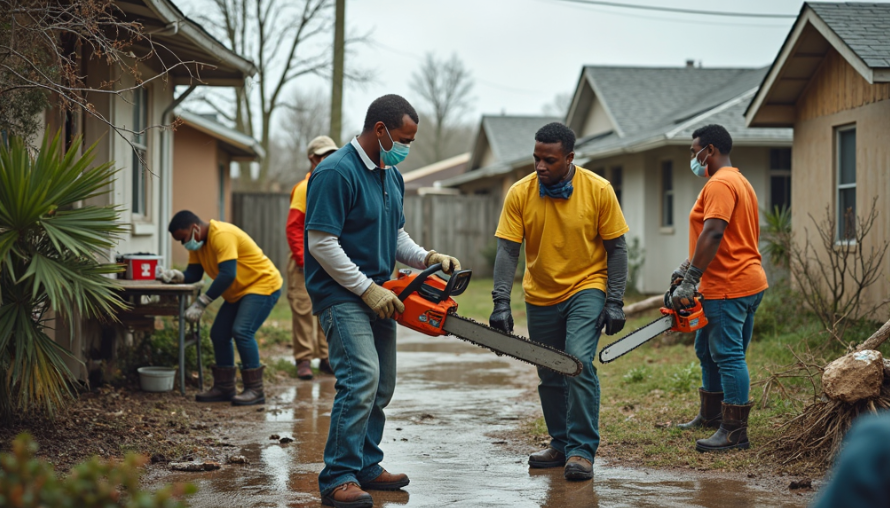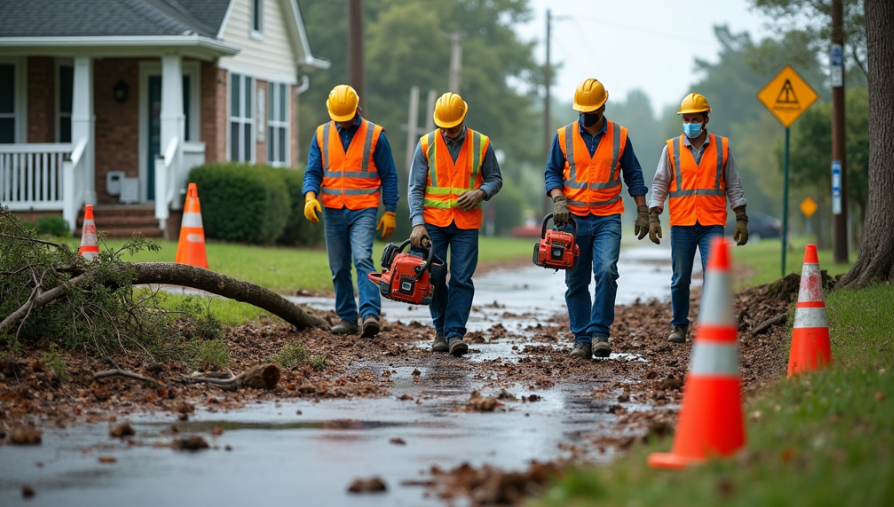Safety measures for hurricane cleanup are crucial for protecting everyone involved in the recovery process. After a hurricane hits, the first instinct is often to jump into action, but it’s vital to prioritize safety first. This means wearing the right personal protective equipment (PPE), knowing how to handle sharp debris, and being aware of hazardous materials. In this article, we’ll dive into practical tips and insights to keep you safe while you help restore your community. By following these guidelines, you’ll be ready to face the challenges of hurricane cleanup while keeping yourself and others safe.
Understanding the Risks of Hurricane Cleanup

When a hurricane hits, the cleanup can be a tough job. It’s important to understand the risks involved to stay safe. Here are some common hazards you might face:
Common Hazards in Hurricane Cleanup
- Sharp debris like broken glass or nails can cause cuts. Always be cautious when moving things around.
- Floodwater contamination is a real danger. It can carry harmful bacteria and chemicals. Make sure to avoid standing water if you can.
- Structural damage risks are everywhere. Buildings might not be stable, so it’s best to watch where you step.
Before you start cleaning up, do a risk assessment. This means looking around to see what could be dangerous and planning how to stay safe. It’s also important to think about environmental hazards. For example, chemicals might spill during a storm, and you need to know how to clean them up safely.
Evaluating Your Safety Gear
One of the best ways to protect yourself is by using personal protective equipment (PPE). Here are some essentials:
- Safety goggles will shield your eyes from flying debris.
- Respirators can help you breathe easier by filtering out harmful dust or chemicals.
- Work gloves are crucial for protecting your hands while you handle debris.
Choosing the right clothing is also important. Consider wearing long sleeves to guard against cuts and the sun. Plus, waterproof boots will keep your feet dry and reduce the risk of infection from cuts or scrapes.
By understanding the risks and gearing up properly, you’ll be prepared to tackle hurricane cleanup safely and effectively!
Safe Debris Removal Techniques

After a hurricane, cleaning up can be tough, but safety comes first. Here are some important ways to handle debris safely.
Proper Techniques for Lifting
When moving heavy debris, remember to use your legs, not your back. This simple trick can prevent injuries. Bend your knees and keep your back straight as you lift. Also, if you can, work with a friend. Teamwork can help share the load and reduce the risk of getting hurt.
Using Power Tools Safely
Power tools can make cleanup easier, but they can also be dangerous. If you’re using a chainsaw, always follow safety protocols. Keep a safe distance from others while you’re cutting. Before using any tools, check them for any issues. Make sure blades are sharp and everything is working correctly to avoid accidents.
Handling Hazardous Materials
During cleanup, you might find hazardous materials like chemicals from flood damage or sewage. These can be very dangerous.
Safety Guidelines for Dealing with Hazards
Check local authorities for safety guidelines on how to dispose of hazardous waste properly. Always wear personal protective equipment (PPE), like gloves and safety goggles, when handling these items. This will help keep you safe from harmful substances.
Remember, taking these safety measures during hurricane cleanup is not just about protecting yourself; it’s also about ensuring that everyone around you stays safe. When we all work together and follow these rules, we can recover from a disaster more effectively and efficiently. So gear up, stay smart, and let’s get to work on making our community safe again!
Post-Cleanup Safety and Mental Health
Checking for Structural Integrity
After a hurricane, it’s crucial to check your home for structural integrity. Look for signs of damage, like cracks in walls or sagging roofs. Conduct a property inspection to find any ongoing risks, such as mold growth or weak structures. Mold can be sneaky, hiding in damp corners, so act quickly to remove it. If you see dangerous debris, wear personal protective equipment (PPE) like gloves and masks to stay safe.
Strategies for Stress Management
The aftermath of a disaster can be overwhelming. The cleanup may leave you feeling stressed or anxious. It’s essential to manage this mental health impact. Stress management strategies can help. For example, take breaks to breathe deeply or talk to family and friends about your feelings. Also, consider joining local recovery groups or using community resources. These groups can provide support and a sense of belonging. Being around others who understand your situation can be very comforting.
Rebuilding Safely
Ensuring Construction Safety
When you’re ready to rebuild, ensure construction safety by engaging in safety training workshops. Learning how to use power tools safely and understanding safety guidelines can prevent accidents. Always have a first aid kit handy in case of minor injuries.
Community Involvement
Lastly, remember the power of community involvement in recovery efforts. Participate in local cleanup initiatives or community meetings. This not only helps you rebuild but also fosters resilience among neighbors. Sharing resources and experiences can make the recovery process smoother and provide a sense of support. Together, you can create a safer, stronger community ready to face any future storm damage.
Ensuring Long-Term Safety
Safety Checklist for Cleanup Efforts
When a hurricane hits, cleaning up can be a tough job. To keep everyone safe, it’s important to follow a safety checklist. Here are some key items to include:
- Emergency Supplies: Always have water, food, flashlights, and batteries ready. These can help if the power goes out.
- First Aid Kits: Make sure your first aid kit is stocked with band-aids, antiseptic wipes, and any personal medications you might need.
- Personal Protective Equipment (PPE): Wear safety goggles, work gloves, and respirators to protect yourself from hazardous materials and debris.
- Communication Plans: Have a way to stay in touch with family and friends. Carry a charged phone and keep emergency contacts handy.
Following this checklist will help you and your volunteers stay safe while cleaning up after the storm.
The Importance of Flood Insurance
Don’t wait until it’s too late! Having flood insurance is a key part of being ready for the next storm. It helps you cover damage to your home and belongings due to flooding. Think of it as a safety net that catches you when the unexpected happens.
Additionally, consider other protective measures like property inspections before a storm hits. Check for risks around your home, such as tall trees that could fall during high winds. Create evacuation plans for your family and talk about them. Planning can save lives!
By preparing now and following these safety measures for hurricane cleanup, you help ensure the safety of your loved ones and community. Always remember, safety first!
Moving Forward with Safety in Mind
In the wake of a hurricane’s destruction, prioritizing safety becomes more important than ever. From personal well-being to community recovery efforts, taking the right steps can make a significant difference. Whether it’s using proper protective gear, staying informed about local hazards, or having the right tools on hand, preparedness is key to navigating future storms with confidence. If you’re planning a post-hurricane cleanup or starting a construction project, we invite you to explore our extensive selection of high-quality tools and equipment from trusted brands at Rentalex. Visit us at 1022 Skipper Road in Tampa, Florida, or call us at (813)971-9990. We’re here to help make your recovery efforts safer and more efficient!






